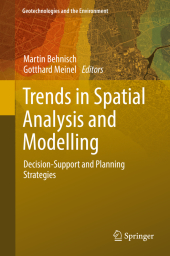 Neuerscheinungen 2017Stand: 2020-02-01 |
Schnellsuche
ISBN/Stichwort/Autor
|
Herderstraße 10
10625 Berlin
Tel.: 030 315 714 16
Fax 030 315 714 14
info@buchspektrum.de |

Martin Behnisch, Gotthard Meinel
(Beteiligte)
Trends in Spatial Analysis and Modelling
Decision-Support and Planning Strategies
Herausgegeben von Behnisch, Martin; Meinel, Gotthard
1st ed. 2018. 2017. xiii, 214 S. 30 SW-Abb., 46 Farbabb., 50 Farbtabellen. 235 mm
Verlag/Jahr: SPRINGER, BERLIN; SPRINGER INTERNATIONAL PUBLISHING 2017
ISBN: 3-319-52520-4 (3319525204)
Neue ISBN: 978-3-319-52520-4 (9783319525204)
Preis und Lieferzeit: Bitte klicken
This book is a collection of original research papers that focus on recent developments in Spatial Analysis and Modelling with direct relevance to settlements and infrastructure. Topics include new types of data (such as simulation data), applications of methods to support decision-making, and investigations of human-environment data in order to recognize significance for structures, functions and processes of attributes. Research incorporated ranges from theoretical through methodological to applied work. It is subdivided into four main parts: the first focusing on the research of settlements and infrastructure, the second studies aspects of Geographic Data Mining, the third presents contributions in the field of Spatial Modelling, System Dynamics and Geosimulation, and the fourth part is dedicated to Multi-Scale Representation and Analysis.
The book is valuable to those with a scholarly interest in spatial sciences, urban and spatial planning, as well as anyone interested in spatial analysis and the planning of human settlements and infrastructure.
Most of the selected papers were originally presented at the "International Land Use Symposium (ILUS 2015): Trends in Spatial Analysis and Modelling of Settlements and Infrastructure" November 11-13 2015, in Dresden, Germany.
Part 1: Towards a better understanding of settlements and infrastructure.- Chapter 1. Reverse engineering of land cover data: Machine learning for data replication in the spatial and temporal domains (Maclaurin).- Chapter 2. Spatial analysis requires a different way of thinking: the problem of spatial heterogeneity (Jiang).- Part 2: Geographic data mining.- Chapter 3: Survey on spatiotemporal and semantic data mining (Yuan).- Chapter 4. Spatial clustering with SOM and GeoSOM (Ba‡Æo).- Chapter 5. Spatial analysis with self-organizing neural networks: SPAWNN Toolkit (Hagenauer).- Part 3: Spatial modelling, system dynamics and geosimulation.- Chapter 6. The evolution of the land development industry. An agent-based simulation model? (Modified re-print) (Almagor).- Chapter 7. Dynamic relationships between human decision making and socio-natural systems (Koch).- Chapter 8. Lessons and challenges in land change modelling derived from synthesis of cross-case comparisons (Gilmore Pontius Jr.).- Part 4: Multi-scale representation and analysis.- Chapter 9. Applications of 3D city models for a better understanding of the built environment (Willenborg).- Chapter 10. An automatic approach for generalization of land-cover data from topographic data (Thiemann).- Chapter 11. Epilogue (Pumain).


